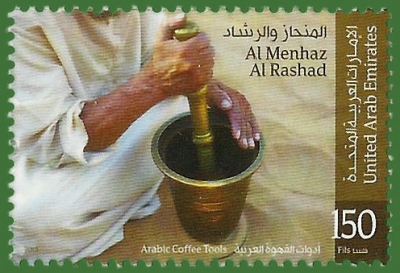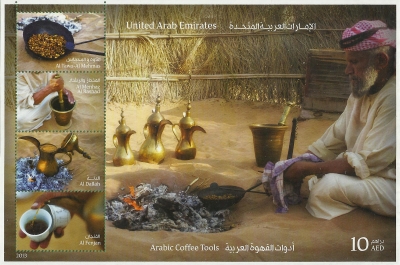-
Arabic Coffee Tools
United Arab Emirates 2013.12.24
In issue: Stamp(s): 4 Souvenir sheet(s): 1
Printing: multicoloral offset
Issued in: sheets of 10 (2*5) stamps
-
Number by catalogue: Michel: 1170
Perforation type: 13 ½x13 ½
Subject:
1.5 dirham. The stamp depicts a man grinding coffee beans with a traditional mortar and engraved pestle.
Topics: Mortars and grinding stones
-
Perforation type: 13 ½x13 ½
Subject:
10 dirham. The Souvenir sheet is issued with four non-nominal coupons - the subjects on them are the same as on the issue stamps.
The main field of the sheet contains a picture of a Bedouin performing a coffee ritual**
Additional:
**The earliest credible evidence of either coffee drinking or knowledge of the coffee tree appears in the middle of the 15th century, in Yemen's Sufi monasteries.
Sufis used it to keep themselves alert during their nighttime devotions. A translation of Al-Jaziri's manuscript traces the spread of coffee from Arabia Felix (the present day Yemen) northward to Mecca and Medina, and then to the larger cities of Cairo, Damascus, Baghdad, and Constantinople. In 1511, it was forbidden for its stimulating effect by conservative, orthodox imams at a theological court in Mecca.
However, these bans were to be overturned in 1524 by an order of the Ottoman Turkish Sultan Suleiman I, with Grand Mufti Mehmet Ebussuud el-İmadi issuing a fatwa allowing the consumption of coffee.
In Cairo, Egypt, a similar ban was instituted in 1532, and the coffeehouses and warehouses containing coffee beans were sacked.Arabic coffee has played a pivotal role in the consolidation of Arab social life, as its councils are said to be schools. Arabic coffee has also contributed to the crystallization of the components of the Arab behavioral system as a symbol of this system. Coffee cups, which may not exceed a few points of bitter taste, and that can overcome the rivalries and the resolution of disputes, and for it may be wars or end, and so the speech of women, and the transgression of revenge, and waiver of rights. It is a positive tool not only in stimulating thought but also as a symbolic medium in promoting the values of generosity and hospitality. It also plays a vital and effective role in the social communication processes between individuals and groups. Arabic coffee is a symbol of generosity, pride and hospitality for the Arabs. It is a tribute to the visitor and has been respected by both its suppliers and its partners. It has resulted in a system of linguistic behavior that indicates the connotations that accompany the process and the ways of presenting it to the other throughout the day. Arabic coffee has entered the familiarities of everyday life, including popular beliefs.
Arabic coffee is made from coffee beans roasted very lightly or heavily from 165 to 210 °C (329 to 410 °F) and cardamom, and is a traditional beverage in Arab culture.
Traditionally, it is roasted on the premises (at home or for special occasions), ground, brewed and served in front of guests. It is often served with dates, dried fruit, candied fruit or nuts. Arabic coffee, is defined by the method of preparation and flavors, rather than the type or roast beans. Arabic coffee is boiled coffee that is not filtered, made black, and if sugar is added, it is added only during preparation. It is served in a small delicate cup without handles, called finjān.
Sometimes, the coffee is moved to a larger and more beautiful pour pitcher to serve in front of the guests, called Della. Often, though, the host prepares coffee in the kitchen and highlights a tray of small cups of coffee.
Unlike its Turkish counterparts, traditional Arabic coffee, with its roots in Bedouin tradition, is usually unsweetened (qahwah saada), but sugar is occasionally added. However, this coffee is never sweet syrup, but rather strong and bitter. To make up for the bitter flavor, coffee is usually served with something sweet – dates are a traditional accompaniment – and other desserts are often served along with a tray of coffee cups.__________
This information has been taken from Wikipedia
Size (of sheet, booklet) mm: 180x120
Topics: Mortars and grinding stones




